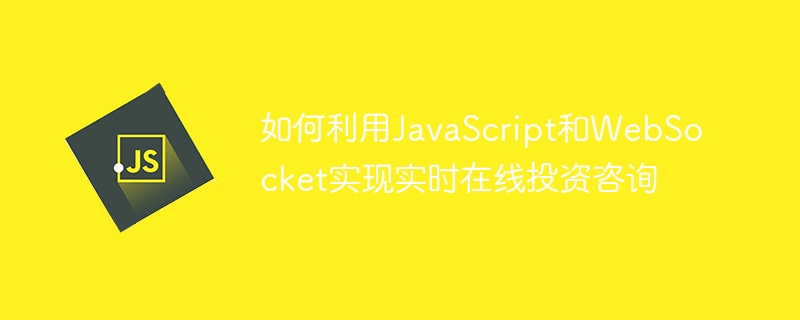

How to use JavaScript and WebSocket to achieve real-time online investment consultation
In the modern financial field, real-time online investment consultation is crucial for investors and business institutions of. In the past, when investors needed to consult an analyst, they often spent a lot of time waiting for a response. Now, by combining the real-time capabilities of JavaScript and WebSocket, we can achieve real-time online investment consultation, which not only saves time, but also improves efficiency. Here's how to achieve this using JavaScript and WebSocket.
Step one: Establish a WebSocket connection
To realize the exchange of real-time online investment consulting information, we need to establish a WebSocket connection first. WebSocket is a network protocol for two-way communication over a single TCP connection. Establishing a WebSocket connection in JavaScript is very simple and can be achieved with the following code snippet:
var webSocket = new WebSocket('ws://localhost:8080');
webSocket.onerror = function(event) {
console.error('WebSocket error:' + JSON.stringify(event));
};
webSocket.onopen = function(event) {
console.log('WebSocket connected.');
};
webSocket.onmessage = function(event) {
console.log('WebSocket message received:' + event.data);
};Here we establish a connection to the WebSocket server on localhost port 8080. When the WebSocket connection is established, we will receive an onopen event and print any messages we receive through the onmessage event handler.
Step 2: Create a chat room
In practical applications, we need a way to display interactive information between investors and consultants, which is achieved through chat rooms. In this chat room, investors and consultants can send and receive messages. In order to create a chat room, we need to add the following code in the HTML file:
<div class="chat-window">
<div class="chat-area"></div>
<form id="chat-form">
<input type="text" id="message-input" placeholder="Type message here...">
<button type="submit" class="send-button">Send</button>
</form>
</div>We have added a chat window master in the HTML file, which includes a chat area and a form to allow investors and consultants send Message. We need to write logic in JavaScript code to complete form submission and process chat messages.
Step Three: Send and Receive Messages
Sending and receiving messages in our WebSocket connection can be achieved through the following code:
function sendMessage() {
var messageInput = document.getElementById('message-input');
var message = messageInput.value;
webSocket.send(message);
messageInput.value = '';
}
document.getElementById('chat-form').addEventListener('submit', function(event) {
event.preventDefault();
sendMessage();
});
webSocket.onmessage = function(event) {
var message = event.data;
var chatArea = document.querySelector('.chat-area');
chatArea.innerHTML += '<div class="message">' + message + '</div>';
};Here we define a sendMessage function , this function reads the message entered by the user from the input box, sends the message to the WebSocket server, and clears the input box. We also added an event listener to call the sendMessage function when the user submits a message in the form.
The WebSocket.onmessage event handler gets the data from the received event (in this case, the message) and adds it to the chat area. By using the innerHTML attribute we can easily attach new messages to the chat window.
Sample code
The following is a complete JavaScript code example that demonstrates how to use WebSocket to implement real-time online investment consultation.
var webSocket = new WebSocket('ws://localhost:8080');
webSocket.onerror = function(event) {
console.error('WebSocket error:' + JSON.stringify(event));
};
webSocket.onopen = function(event) {
console.log('WebSocket connected.');
};
function sendMessage() {
var messageInput = document.getElementById('message-input');
var message = messageInput.value;
webSocket.send(message);
messageInput.value = '';
}
document.getElementById('chat-form').addEventListener('submit', function(event) {
event.preventDefault();
sendMessage();
});
webSocket.onmessage = function(event) {
var message = event.data;
var chatArea = document.querySelector('.chat-area');
chatArea.innerHTML += '<div class="message">' + message + '</div>';
};Open this code in the browser and deploy the WebSocket server on port 8080 of the local host. Enter your message in the chat window and press the "Send" button, your message will automatically appear in the chat area.
Conclusion
Using JavaScript and WebSocket for real-time online investment consultation will greatly improve the communication efficiency between investors and business institutions in the financial field. With the help of WebSocket connection and simple JavaScript code, we can easily implement real-time online investment consultation. Whether you want to start a business or tweak a project, the above methods can be applied to help achieve greater productivity.
The above is the detailed content of How to use JavaScript and WebSocket to achieve real-time online investment consultation. For more information, please follow other related articles on the PHP Chinese website!
